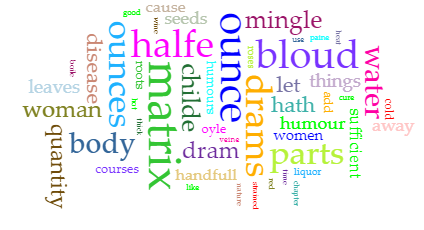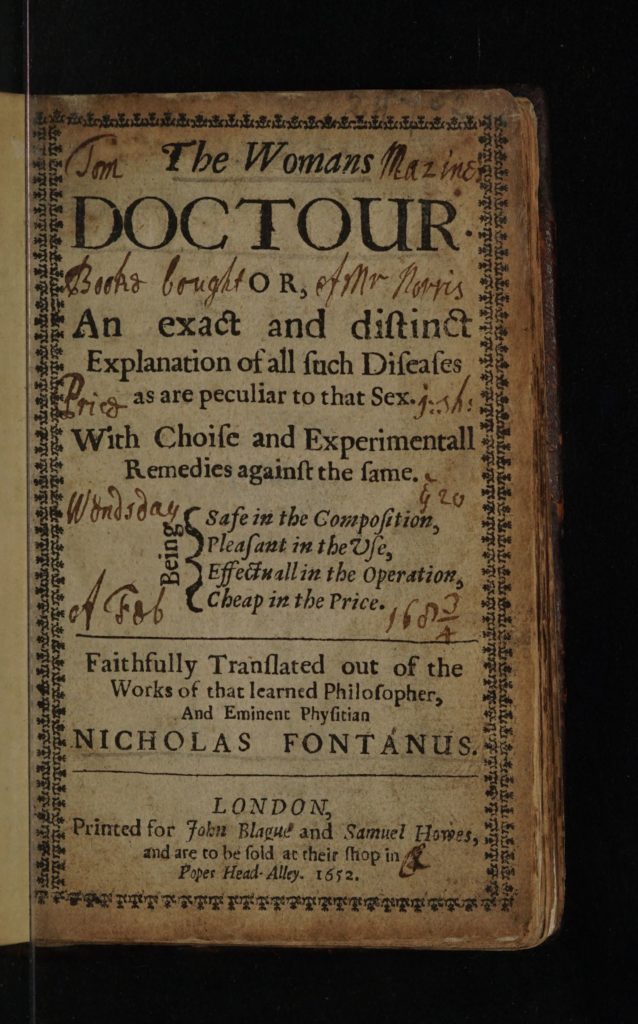A Womans Doctour
| Title | The womans doctour, or, An exact and distinct explanation of all such diseases as are peculiar to that sex with choise and experimentall remedies against the same |
|---|---|
| Contributor(s) |
Fonteyn, Nicolaas
(author) |
| Year | 1652 |

This is a visualisation taken from Voyant Tools which shows the most common words and concerns of this text and how it pertains to the female body. We can see how remedies are suggested to care for the body from words like ‘ounces’, ‘handfull’, ‘dram’ ; these are herbal remedies thought to enable healing of women’s illnesses. Humoural theory plays an important role in this work, as does the menstrual cycle (‘bloud’, ‘quantity’).
Initially published in 1644 in Latin by the Dutch author Nicolaas Fonteyn (16..-16..), Syntagma medicum de morbis mulierum in libros IV was translated into English in 1652 under the title The womans doctour, or, An exact and distinct explanation of all such diseases as are peculiar to that sex with choise and experimentall remedies against the same. The identity of the translator is unknown but the English publishers assert in the introduction that it was “faithfully translated out of the works of that learned philosopher and eminent physitian Nicholas Fontanus” (Fonteyn, 1644/1652, n. pag., our emphasis). The use of this adjective in the title page is an important aspect of Early Modern era book circulation, where references to a Latin text increased prestige.
Fonteyn subscribes to the idea that the female body is mysterious and secretive and that this intricate knowledge can be shared by the select few. He dismisses other contemporary work in his preface to the reader, claiming one writes with “with so much tediousness, and confusion; that you may sooner finde your Patient dead, then a remedy in his writings for her recovery” (1644/1652, p. iii).
Fonteyn was an avid Galenic author, explaining the female body as connected to her humoral balance. Throughout the text, Fonteyn refers to women as ‘her’ and uses the imperative form of the verb, indicating that his audience is general medical practitioners seeking to understand and aid their female patients. Midwives are mentioned sparingly, but not critically, suggesting perhaps that Fonteyn is cognisant of their contributions to female health, while placing more emphasis on the general needs of women and not the specific case of the female body in pregnancy and birth.

This graph allows us to visualise how words are related to one another inside the text. The uterus (‘matrix’) is connected to ailments: ‘swelling’ and ‘inflammation’ but also to its physical description: ‘parts’ and its importance to the medicalised female body : ‘matrix’. Remedies are given : ‘mingle’ and ‘ounce’, while the womb’s role in releasing menstrual blood is also important (‘bloud’).

Consult the source
This source was downloaded from the Internet Archive and hosted here for educational purposes in the framework of our research project. Link valid 12/08/2023.
Source
We consulted one version of the text, the 1652 transcribed English translation hosted by the University of Michigan, which also served as the source to our .txt data file. The images displayed here are taken from WellCome Collection and the Internet Archive, both from 1652. The source presented to the site visitor was taken from the Internet Archive.



